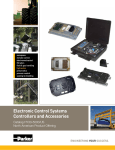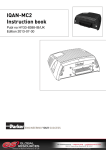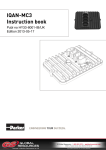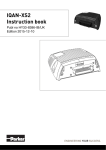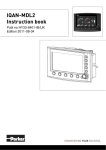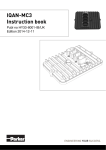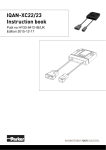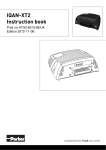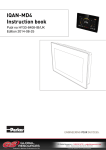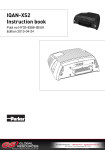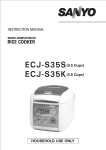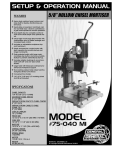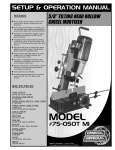Download User Manual
Transcript
IQAN-XC10 Instruction book Publ. no. HY33-8407-IB/UK Edition 2013-06-25 Contents 1 Introduction . . . . . . . . . . . . . . . . . . . . . . . . . . . . . . . . . . . . . . . . . . . . . . . . . . . . 1 Warnings . . . . . . . . . . . . . . . . . . . . . . . . . . . . . . . . . . . . . . . . . . . . . . . . . . . . 1 Overview of relevant documentation . . . . . . . . . . . . . . . . . . . . . . . . . . . . . . . 2 2 Precautions . . . . . . . . . . . . . . . . . . . . . . . . . . . . . . . . . . . . . . . . . . . . . . . . . . . . 3 Read This . . . . . . . . . . . . . . . . . . . . . . . . . . . . . . . . . . . . . . . . . . . . . . . . . . . . 3 3 Product description . . . . . . . . . . . . . . . . . . . . . . . . . . . . . . . . . . . . . . . . . . . . . 5 IQAN-XC10 . . . . . . . . . . . . . . . . . . . . . . . . . . . . . . . . . . . . . . . . . . . . . . . . . . 5 4 Safety . . . . . . . . . . . . . . . . . . . . . . . . . . . . . . . . . . . . . . . . . . . . . . . . . . . . . . . . . 7 Internal diagnostics . . . . . . . . . . . . . . . . . . . . . . . . . . . . . . . . . . . . . . . . . . . . 7 CAN-bus interruption . . . . . . . . . . . . . . . . . . . . . . . . . . . . . . . . . . . . . . . . . . . 7 Emergency stop . . . . . . . . . . . . . . . . . . . . . . . . . . . . . . . . . . . . . . . . . . . . . . . 7 5 Mounting . . . . . . . . . . . . . . . . . . . . . . . . . . . . . . . . . . . . . . . . . . . . . . . . . . . . . . 8 Mounting the module . . . . . . . . . . . . . . . . . . . . . . . . . . . . . . . . . . . . . . . . . . . 8 6 Installation . . . . . . . . . . . . . . . . . . . . . . . . . . . . . . . . . . . . . . . . . . . . . . . . . . . . 10 Supply Voltage . . . . . . . . . . . . . . . . . . . . . . . . . . . . . . . . . . . . . . . . . . . . . . . 12 CAN installation and terminating . . . . . . . . . . . . . . . . . . . . . . . . . . . . . . . . . 14 Voltage inputs . . . . . . . . . . . . . . . . . . . . . . . . . . . . . . . . . . . . . . . . . . . . . . . 15 Digital inputs . . . . . . . . . . . . . . . . . . . . . . . . . . . . . . . . . . . . . . . . . . . . . . . . . 16 Frequency inputs . . . . . . . . . . . . . . . . . . . . . . . . . . . . . . . . . . . . . . . . . . . . . 17 Proportional outputs . . . . . . . . . . . . . . . . . . . . . . . . . . . . . . . . . . . . . . . . . . . 18 Digital outputs . . . . . . . . . . . . . . . . . . . . . . . . . . . . . . . . . . . . . . . . . . . . . . . 19 Low-side digital outputs . . . . . . . . . . . . . . . . . . . . . . . . . . . . . . . . . . . . . . . . 20 7 Start-up . . . . . . . . . . . . . . . . . . . . . . . . . . . . . . . . . . . . . . . . . . . . . . . . . . . . . . . 22 Start-up procedures . . . . . . . . . . . . . . . . . . . . . . . . . . . . . . . . . . . . . . . . . . . 22 8 System Diagnostics . . . . . . . . . . . . . . . . . . . . . . . . . . . . . . . . . . . . . . . . . . . . 23 Status LEDs . . . . . . . . . . . . . . . . . . . . . . . . . . . . . . . . . . . . . . . . . . . . . . . . . 23 Appendix A . . . . . . . . . . . . . . . . . . . . . . . . . . . . . . . . . . . . . . . . . . . . . . . . . . . 24 IQAN-XC10 Technical Overview . . . . . . . . . . . . . . . . . . . . . . . . . . . . . . . . . 24 Appendix B . . . . . . . . . . . . . . . . . . . . . . . . . . . . . . . . . . . . . . . . . . . . . . . . . . . 27 Error codes, messages and actions . . . . . . . . . . . . . . . . . . . . . . . . . . . . . . . 27 Appendix C . . . . . . . . . . . . . . . . . . . . . . . . . . . . . . . . . . . . . . . . . . . . . . . . . . . 28 Dimensioning of the IQAN-XC10 module . . . . . . . . . . . . . . . . . . . . . . . . . . . 28 Instruction book, IQAN-XC10 ii Warnings 1 1 Introduction Introduction These instructions are to be used as a reference tool for the vehicle manufacturer’s design, production, and service personnel. The user of these instructions should have basic knowledge in the handling of electronic equipment. Warnings Sections marked with a symbol in the left margin, must be read and understood by everyone using the system, carrying out service work, or making changes to hardware and software. The different symbols used in this manual are defined below. WARNING Sections labeled WARNING with a caution symbol in the left margin, indicate that a hazardous situation exists. We use warnings, marked with the warning symbol, in two ways. • As a strong recommendation about work practices when using the product in the machine (e.g. routines when updating an application). This use is common to the term 'hazardous situation', that a person is exposed to a hazard. • As a way of pointing out important information for the machine designer that in some way relates to safety. This includes the design of the physical machine, and also the application program being developed for the control system. Not all document sections that contain information about safety are marked with a warning symbol (there would be warnings everywhere). Failure to comply with the recommendations can cause unintentional, and unexpected behavior of the control system. This can potentially cause death, serious injury or property damage. N OTICE Sections labeled NOTICE with a notice symbol in the left margin, indicate there is important information about the product. Ignoring this could result in less than optimal performance, or damage to the product. Contact the manufacturer if there is anything you are not sure about or if you have any questions regarding the product and its handling or maintenance. The term "manufacturer" refers to Parker Hannifin Corporation. Instruction book, IQAN- XC10 1 Overview of relevant documentation 1 Introduction Overview of relevant documentation The following publications are relevant for users of this product. The main documentation contains information that is not found elsewhere. The additional documentation contains product information in a compact format, for details on the information found in those documents, consult this manual. Main Documentation Compact Documentation IQANdesign User Manual IQAN-XC10 Instruction Book HY33-8406-IB (this book) IQAN-XC10 Catalogue Datasheet HY33-8406 IQAN-XC10 Installation Sheet HY33-8406-IS IQAN-XC10 Electrical Schematic HY33-8406-ES The IQAN-XC10 module documentation system. 2 Instruction book, IQAN- XC10 2 Read This 2 2 Precautions Precautions Work on the hydraulics control electronics may only be carried out by trained personnel who are well-acquainted with the control system, the machine and its safety regulations. WARNING Make sure that you have sufficient knowledge before designing, modifiying or servicing the control system. Read the relevant sections of this document before conducting any work on the control system. WARNING This product is not field repairable. N OTICE As much as possible of the welding work on the chassis should be done before the installation of the system. If welding has to be done afterwards, the electrical connections on the system must be disconnected from other equipment. The negative cable must always be disconnected from the battery before disconnecting the positive cable. The ground wire of the welder shall be positioned as close as possible to the place of the welding. The cables on the welding unit shall never be placed near the electrical wires of the control system. Read This Design of control system WARNING Risk of injury may be introduced by design of control system! This product is designed to control hydraulic outputs. The control application must be designed using basic safety principles so that unintentional movement is avoided. The machine must be equipped with an emergency stop that stops all movement. Please refer to section Emergency stop, on page 7. Before you start Read this document, as a minimum sections 1-7 Read the IQANdesign software user manual section on 'application safety'. 3 Instruction book, IQAN- XC10 3 Read This 2 Precautions Start-up, maintenance, and diagnostics For all personnel carrying out installation, commissioning, maintenance or troubleshooting. WARNING Work on the hydraulics control electronics may only be carried out by trained personnel who are well-acquainted with the control system, the machine and its safety regulations. Before you start, Read section Start-up, on page 22. Additional information for service Mounting and maintenance instruction book. Additional information for diagnosing the system Read section System Diagnostics, on page 23, and see Appendix B, on page 27, in this document. Use the IQANrun software user manual as a reference. 4 Instruction book, IQAN- XC10 4 IQAN-XC10 3 3 Product description Product description IQAN-XC10 The IQAN-XC10 is an IQAN compatible variant of the VMM3120, that is based on the Parker Vansco CM3620 hardware platform. It is used as an expansion module in an IQANdesign platform electronic control system. The IQAN-XC10 is one out of several expansion modules designed for controlling hydraulic systems in vehicles and machinery. The IQAN-XC10 module. I/O overview ADDR +BAT -BAT +VREF CAN-H -VREF CAN-L XC10 VIN DOUT DIN PWMOUT FIN Inputs The IQAN-XC10 module has ten (10) voltage inputs VIN-A thru VIN-J for connecting of 0-5 Vdc signals. For flexibility these inputs may also be configured as up to ten (10) digital inputs. (10) Voltage inputs VIN-A, VIN-B, VIN-C....VIN-J or (10) Digital inputs DIN-Q, DIN-R, DIN-S.... DIN-Z The module has sixteen (16) dedicated digital inputs and (4) frequency inputs. (16) Digital inputs DIN-A, DIN-B.... DIN-P (4) Frequency inputs, FIN-A, FIN-B, FIN-C, FIN-D 5 Instruction book, IQAN- XC10 5 IQAN-XC10 3 Product description Outputs The IQAN-XC10 module has eight (8) dedicated digital outputs (on/off) for controlling solenoid valves or relays. (8) Dedicated digital outputs DOUT-A ... DOUT-H Proportional outputs The IQAN-XC10 module also has four (4) double proportional outputs for controlling proportional valves. These outputs can control four bi-directional valve sections or up to eight single solenoid devices (ie. proportional cartridge valves). For flexibility these outputs may also be configured as up to twelve (12) on/off outputs. The proportional outputs and on/off outputs share positions, see below. (4) Double proportional outputs PWM-A+/- ... PWM-D+/or (12) Digital outputs high-side, DOUT-I ... DOUT-P; low-side, DOUT-Q ... DOUT-T CAN related functions The master uses the CAN-bus (CAN = Control Area Network) to communicate with the XC10 module. The CAN-bus is a robust communication protocol that is widely used and well proven within the automotive industry. 6 Instruction book, IQAN- XC10 6 Internal diagnostics 4 4 Safety Safety Internal diagnostics The module performs a number of self-checks that improve safety. Checks include monitoring of voltage supplies, checksums on memory and a watchdog that monitors software execution. If a critical error is detected, the module is stopped, with CAN-bus and outputs off. Outputs The IQAN-XC10 protocol supports the detection of open-load and overload on PWM outputs. CAN-bus interruption The IQAN-XC10 communicates with an IQAN master module on the CAN-bus. Both the master and the IQAN-XC10 check for any interruptions in the CAN-bus communication. If an error occurs the master will use zero, or an application defined error value for the inputs, and the outputs will be off. The error will be indicated both on the master module and with a blink code on the unit, see Appendix B, on page 27. Emergency stop WARNING Risk of injury! The emergency stop must disconnect the power supply to the module; do not connect the emergency stop as a signal input only. The emergency stop must be installed so that the risk of reverse feed of the module is avoided, see section Installation, on page 10. 7 Instruction book, IQAN- XC10 7 Mounting the module 5 5 Mounting Mounting Mounting the module The IQAN-XC10 can be installed in the vehicle's cab, or on the chassis. If used for a marine application, ensure it is protected from excessive salt spray. Before mounting the module, ensure you review the following environmental and mechanical requirements. Environmental Requirements N OTICE The warranty does not cover damage to the product when exposed to environmental conditions that exceed the design limitations of the product. Review the following environmental specifications before selecting a mounting location for the IQAN-XC10: • The module must be in an environment that is within its ambient temperature range. Safe operating temperature range for a XC10 is –40°C to +85°C. N OTICE Do not install the IQAN-XC10 close to any significant heat sources, such as a turbo, exhaust manifold, etc. Also avoid installing the module near any drive-train component, such as a transmission or engine block. • The module must be in an environment that does not exceed its particle ingress rating. The sealing standard for the IQAN-XC10 is EP455 level 1 (IPX6). • The module should be protected from aggressive pressure wash up to 1000 psi. N OTICE The severity of a pressure wash can exceed the module’s pressure wash specifications related to water pressure, water flow, nozzle characteristics, and distance. Under certain conditions a pressure wash jet can cut wires. Mechanical Requirements Review the following mechanical requirements before selecting a mounting location for the IQAN-XC10: • The harness should be shielded from harsh impact. • The harness should connect easily to the connector and have adequate bend radius. • The labels should be easy to read. • The module should be in a location that is easily accessible for service. The following guidelines are related to physically attaching the IQAN-XC10 to a vehicle: • The IQAN-XC10 should be secured with bolts in all four bolt holes using 1/4"-20 Hex Head or equivalent metric size (6 mm) bolts. • The bolts should be tightened according to the fastener manufacturer's tightening torque specifications. 8 Instruction book, IQAN- XC10 8 Mounting the module 5 Mounting • The IQAN-XC10 should be mounted vertically so moisture will drain away from it. This will prevent icing damage to the connectors. Approved mounting orientations 9 Instruction book, IQAN- XC10 9 Mounting the module 6 6 Installation Installation Connector C1 (black) Connector AMP Superseal Housing AMP no. 776164-1 Strain relief (optional) AMP no. 776463-1 Pin type AMP no. 770854-3 Cable 0,75 mm2 (18AWG) Crimping tool AMP no. 58529-1 Connector C1 pin assignments Pin Signal Pin Signal Pin Signal 1 PWM-A+/DOUT-I 13 PWM-A-/DOUT-J 24 PWM-B+/DOUT-K 2 +BAT 14 -BAT 25 PWM-B-/DOUT-L 3 +BAT 15 -BAT 26 DOUT-A 4 +BAT 16 -BAT 27 DOUT-B 5 +BAT 17 -BAT 28 +VREF 6 +BAT 18 VIN-B/DIN-R 29 FIN-B 7 VIN-A/DIN-Q 19 VIN-D/DIN-T 30 FIN-A 8 DIN-G 20 DIN-E 31 VIN-C/DIN-S 9 DIN-D 21 DIN-C 32 DIN-F 10 DIN-B 22 DIN-A 33 CAN-L 11 POWER CONTROL 23 RESERVED 34 CAN-H 12 PWMRET-A/ DOUT-Q (LS) 35 PWMRET-B/ DOUT-R (LS) 10 Instruction book, IQAN- XC10 10 Mounting the module 6 Installation Connector C2 (white) Connector AMP Superseal Housing AMP no. 776164-2 Strain relief (optional) AMP no. 776463-1 Pin type AMP no. 770854-3 Cables 0,75 mm² (18 AWG) Crimping tool AMP no. 58529-1 Connector C2 pin assignments Pin Signal Pin Signal Pin Signal 1 PWMRET-C/ DOUT-S (LS) 13 DIN-H 24 PWMRET-D/ DOUT-T (LS) 2 DIN-J 14 RESERVED 25 DIN-I 3 DIN-L 15 RESERVED 26 DIN-K 4 PWM-C+/DOUT-M 16 DIN-N 27 DIN-M 5 PWM-C-/DOUT-N 17 DIN-O 28 DIN-P 6 PWM-D+/DOUT-O 18 VIN-E/DIN-U 29 ADDRESS-0 7 PWM-D-/DOUT-P 19 VIN-G/DIN-W 30 VIN-F/DIN-V 8 DOUT-C 20 VIN-I/DIN-Y 31 VIN-H/DIN-X 9 DOUT-D 21 FIN-D 32 VIN-J/DIN-Z 10 DOUT-E 22 -VREF 33 FIN-C 11 DOUT-F 23 DOUT-H 34 ADDRESS-1 12 DOUT-G 35 ADDRESS-2 N OTICE The universal connector kit, Parker p/n 0916022ECD, is compatible with this unit. The kit includes housings and pins to acommodate any 1 of the following modules: IQAN-XC10, VMM3120, VMM2404 or VMM0604. Not all parts packaged in the universal kit will be used. 11 Instruction book, IQAN- XC10 11 Supply Voltage 6 Installation Supply Voltage Before any installation of the IQAN system can take place, make sure the ignition lock is turned off and the battery is disconnected. Emergency stop Make sure an Emergency Stop disconnecting the power supply, is easily accessible at any time. The figure below shows how to connect the emergency stop. Connecting of Supply Voltage The supply voltage, should be within the operating interval, see Appendix A, on page 24. The IQAN-XC10 power and ground connections are paralleled over several pins to minimize voltage drops on higher current applications. The number of connector pins needed to connect power depends on the amount of current required by the application. The module is protected against reverse battery connections by an internal high-current conduction path from ground to power. When connecting power, it is important to follow these best practices: • For power and ground connections, use one 16 AWG wire per 8 A of expected output load. • To protect the IQAN-XC10 from damage in a reverse battery condition, place a fuse of 50 A or less (according to power usage with all outputs on) in series with the module power wires in the application harness. Connect the supply voltage to +BAT pins, C1:2 thru 6. Protect the module by using a fuse. Requisite fuse level should be 50 A max.(fast) for +BAT. Ground connection is made from -BAT pins, C1:14 thru 17 to the negative terminal on the battery. IQAN-XC10 Emergency Stop Fuse * + - +BAT +BAT +BAT +BAT +BAT -BAT -BAT -BAT -BAT * Symbol for disconnecting switch for battery, ignition lock and other fuses. Connecting the emergency stop and voltage supply. N OTICE Do not use the chassis as the negative terminal. Use a common wire size for all +BAT and -BAT connections to avoid damage from high current being passed through a smaller cross section wire. Polarity reversal The IQAN-XC10 module is protected against power supply polarity reversal. An external fuse, max 50A (Fast) must be used. Polarity reversal can damage the unit if the fuse is not used. 12 Instruction book, IQAN- XC10 12 Supply Voltage 6 Installation Reverse feed WARNING Risk of inadvertently supplying power to the module! If any of the outputs are short circuited to battery voltage, the module will be powered by reverse feed of voltage, even when the connection to module power is off. Power control input When the VMM3120 hardware has been configured as an IQAN-XC10, the power control input and ’sleep mode’ functionality is not used. It is required to always have POWER CONTROL, pos. C1:11 connected to the battery, +BAT. IQAN-XC10 POWER CONTROL Fuse * + - * Symbol for disconnecting switch for battery, ignition lock and other fuses. Connecting the power control input to voltage supply. N OTICE In order to receive the IO configuration from the master, which is sent at startup, the expansion module needs to be awake. Additionally, if the power control is not connected, then the LED’s are off, so there are no diagnostics. 13 Instruction book, IQAN- XC10 13 CAN installation and terminating 6 Installation CAN installation and terminating Addressing Each IQAN-XC10 will have a specific address, enabling the master module to communicate with the modules through the CAN-bus. When operating, the system distinguishes between different modules by first verifying the module type and secondly, through the modules having unique addresses. EXAMPLE If having an IQAN-XC10 module with address 0 on CAN-bus A, the system will denote this one as XC10-A0. Addressing is carried out by putting a jumper to ground in the C2 connector on the appropriate pin. There can be a maximum of 3 IQAN-XC10 modules on each CAN bus in a system, address 0, 1, 2. Module Address Pin / ADDRESS 2 Pin / ADDRESS 1 Pin / ADDRESS 0 0 NC NC GND 1 NC GND NC 2 GND NC NC Terminating To eliminate interference in the communication, through the CAN-bus, the CAN-bus must be terminated. If an IQAN-XC10 is located at the end of the CAN-bus, the CANbus must be terminated close to the connector at the IQAN-XC10. It is the terminator’s task to end the signals on the CAN-bus, to eliminate interference in the system’s communication. If there is no terminator, there can be complete or partial interference with the communication on the CAN-bus. The most important factors for a properly constructed CAN-bus are: • a termination between CAN-H and CAN-L has to be used at the end of the bus. • keep the drops to the XC10 modules short. N OTICE Do not terminate the bus in the XC10 connector. Double crimping wires in the connector will cause the environmental specification to not be met. The preferred method is to have a drop to the module (<0.5m length) and terminate the CAN-bus at its end in the harness. CAN Protocol The module uses ICP (IQAN CAN Protocol) to communicate with the master. You should only install IQAN-XC10 on a CAN-bus with other IQAN modules, do not mix with other protocols, such as J1939. 14 Instruction book, IQAN- XC10 14 Voltage inputs 6 Installation Voltage inputs Connecting sensors to the voltage inputs The sensor signal range must be 0-5 Vdc. To detect signal errors such as short circuits or interruptions the active signal range should be within 0.5-4.5 Vdc. [V 5 Error detection range Active signal 0 Error detection range t Active signal range. The positive terminal of the sensor is connected to the +VREF position and the corresponding negative terminal to the -VREF position. The sensor signal is connected to the appropriate VIN position. Connection as per illustration. EXAMPLE Connect the positive and negative terminals of the position sensor to +VREF, position C1:28, and -VREF, position C2:22, respectively. Then connect the sensor signal to VIN-A, position C1:7. IQAN-XC10 +VREF VIN-A -VREF Connecting VREF and sensor signal. N OTICE The negative terminal of the sensor must not be connected to the chassis. Maximum load for VREF position, see Appendix A, on page 24. 15 Instruction book, IQAN- XC10 15 Digital inputs 6 Installation Connecting switches to the voltage inputs Switches could be connected to the voltage inputs, to create a digital on/off signal. The switches should be connected to +VREF and VIN respectively for 5V signal. The current consumption for the voltage input is negligible. EXAMPLE Connect the positive and negative terminals of the switch to +VREF, position C1:28, and VIN, e.g. position C1:7, respectively. IQAN-XC10 +VREF VIN-A Connecting a switch to VIN-A. N OTICE Maximum load for VREF position, see Appendix A, on page 24. Digital inputs It is recommended to connect system voltage +BAT to the input through a switch in order to reserve 5Vdc VREF for sensors and potentiometers.. EXAMPLE Connect the positive and negative terminals of the switch to +BAT, and DIN, e.g. position C1:22, respectively. +BAT IQAN-XC10 DIN-A Connecting a switch to DIN-A. 16 Instruction book, IQAN- XC10 16 Frequency inputs 6 Installation Frequency inputs Connecting sensors to the frequency inputs IQAN-XC10 frequency inputs can operate only in speed mode, which is frequency. For the frequency ranges and trigger levels, see Appendix A, on page 24. Simple frequency sensor The positive terminal of the frequency sensor is connected to the +VREF and the negative terminal to the -VREF respectively. The sensor signal is connected to one of the FIN positions, FIN-A thru FIN-D. The sensor signals must conform to the trigger levels for the input, see Appendix A, on page 24. Depending on the sensor used, or if the current consumption for the sensor exeeds the maximum load for the VREF, the sensor could be connected to the +BAT/-BAT positions.. EXAMPLE Connect the positive and negative terminals of the frequency sensor to +VREF, position C1:28, and -VREF, position C2:22, respectively. Then connect the sensor signal to FIN-C, e.g. position C2:33. IQAN-XC10 +VREF OR FIN -VREF Connecting a frequency sensor to FIN. N OTICE The negative terminal of the sensor must not be connected to the chassis. Maximum load for VREF position, see Appendix A, on page 24. 17 Instruction book, IQAN- XC10 17 Proportional outputs 6 Installation Proportional outputs The PWM (pulse width modulation) outputs control proportional valves and devices. The IQAN-XC10 PWM outputs operate in voltage, open-loop mode. This means that the output is not regulated and will not compensate for a change in load (e.g. increased resistance due to coils heating up). For current, closed-loop proportional outputs, a different IQAN expansion module should be used. For the PWM output range and loads, see Appendix A, on page 24. Connecting loads to proportional outputs Connecting a load, e.g. one proportional valve section, to the PWM outputs is done by using the PWM/PWMRET paired positions. Protection against voltage transients A clamping diode must be placed between the PWM output and return line, as close to the load as possible. This protects the output against high voltage transients. For example, use diode: 1N5408 (3A/1000V). Depending on the load, other clamping diodes might be used instead. EXAMPLE Positive direction: Connect the proportional valve to the PWM-A+, position C1:1 and the PWMRET-A, position C1:12 respectively. Negative direction: Connect the proportional valve to the PWM-A-, position C1:13 and the PWMRET-A, position C1:12 respectively. IQAN-XC10 PWM-A+ PWM-A- d1 d2 PWMRET-A Connecting a load to a proportional output. 18 Instruction book, IQAN- XC10 18 Digital outputs 6 Installation Digital outputs The digital outputs control relays and on/off valves. For the maximum load per output see Appendix A, on page 24. Connecting loads to digital outputs Connecting of loads to the digital outputs such as on/off valves is done by using the DOUT positions and chassis as ground. Protection against voltage transients A clamping diode must be placed between the digital output and ground, as close to the load as possible. This protects the output against high voltage transients. For example, use diode: 1N5408 (3A/1000V). Depending on the load, other clamping diodes might be used instead. EXAMPLE Connect the on/off valve to the digital output using the DOUT, e.g. position C1:26, and the chassis as ground. A clamping diode must be placed as close to the load as possible, see figure below. IQAN-XC10 DOUT d1 Connecting a load to a digital output. 19 Instruction book, IQAN- XC10 19 Low-side digital outputs 6 Installation N OTICE If the load is controlled in parallel with another system, the digital output must be protected with a diode connected in series with the output. EXAMPLE +BAT IQAN-XC10 d2 DOUT d1 Digital output protected with a diode. Low-side digital outputs The low-side digital outputs may control relays and on/off valves. For the maximum load per output see Appendix A, on page 24. Connecting loads to low-side digital outputs Connecting of loads to the low-side digital outputs such as on/off valves is done by using the DOUT(LS) positions and one or more DOUT channels as supply. Protection against voltage transients A clamping diode must be placed between the source and low-side digital output, as close to the load as possible. This protects the output against high voltage transients. For example, use diode: 1N5408 (3A/1000V). Depending on the load, other clamping diodes might be used instead. EXAMPLE Connect the on/off valves to the low-side digital outputs using a pair of the DOUT(LS) positions, and the DOUT, as supply. A clamping diode must be placed as close to the load as possible, see figure below. IQAN module DOUT d1 DOUT(LS) d2 DOUT(LS) Connecting loads to the low-side digital outputs. 20 Instruction book, IQAN- XC10 20 Low-side digital outputs 6 Installation WARNING Loads on DOUT with Low-Side switch (DOUT[LS]) must always be controlled on the high-side by connection to a digital output with High-Side switch (DOUT) for safe function. 21 Instruction book, IQAN- XC10 21 Start-up procedures 7 7 Start-up Start-up Start-up procedures This chapter contains instructions for action to be taken in connection with the initial start. WARNING Risk of injury! If the control system is not fitted properly, the machine could move uncontrollably. The machine’s engine shall not be started before the control system is completely fitted and its signals are verified. Starting the control system Start the control system as follows: • Prior to start, all modules and cables are to be fitted correctly. • Check fuses, i.e. make sure that the supply voltage to the modules is equipped with the correct fuse. • Make sure that connections for supply voltage and return lines are correct in the cable’s conductor joint. • Make sure an emergency stop is installed. The emergency stop should disconnect the supply voltage to all modules. Alternatively, the emergency stop may also shut off the diesel engine or a dump valve, and with that, depressurize the hydraulic system. Prepare for system start WARNING Make sure no one is in dangerous proximity to the vehicle to avoid injuries when it starts. Prepare for the initial system start as follows: • The engine for the hydraulic system’s pump shall be in off position. • Make sure that all connectors are properly connected. • Turn on the control system. • Make sure that voltage is being supplied to all modules; the power/status diode shall be illuminated on all modules. Also, make sure that the master is in contact with all modules by reading the master’s display. • Make sure the emergency stop is functioning properly. Start the system Start the system as follows: • Start the engine for the hydraulic system’s pump, assuming that the above mentioned inspections have been carried out and shown correct values. • Calibrate and adjust input and output signals according to the instructions related to the master menu system and check each and every output function carefully. 22 Instruction book, IQAN- XC10 22 Status LEDs 8 8 System Diagnostics System Diagnostics Status LEDs The red status LED on the top of the module indicates normal operation/power on with a 1 Hz blinking ’heartbeat’. If there is an error detected, the module will present an error indication through a combination of red/status and red/error blinking LEDs. This gives an immediate diagnosis as to the nature of the error that has occurred. red - power /status red - error LEDs on top of IQAN-XC10 module To get further information about the error messages, see Appendix B, on page 27. A small recommendation . . . You can use the internal diagnostics in the master to get more information about the XC10 module. The following values are supervised: Internal temperature [°C] Power supply [V] Reference voltage [V] 23 Instruction book, IQAN- XC10 23 IQAN-XC10 Technical Overview Appendix A Appendix A IQAN-XC10 Technical Overview Absolute Maximum Ratingsa Ambient temperature, -40 to +85 °C Storage temperature -40 to +85 °C Voltage supply on +BAT 7.5 to 32 Vdc (can withstand 36 Vdc for 5 minutes) Voltage on any pin with respect to -BAT 32 Vdc Power driver load Total load on power drivers < 37A a.The “Absolute Maximum Ratings” table lists the maximum limits to which the device can be subjected without damage. This doesn´t imply that the device will function at these extreme conditions, only that, when these conditions are removed and the device operated within the “Recommended Operating Conditions”, it will still be functional and its useful life wonít have been shortened. Environmental ratings Climate environment Enclosure, water & dust protection Salt mist IEC 60529:2001, IPX6 J1455 (Aug 94) Section 4.3.3, 48 hrs Mechanical environment Random vibration Shock J1455(Aug 94) Section 4.9.4.2, 8 hrs J1455(Aug 94), EP455 Section 5.14.1 EMC Radiated emission Conducted susceptability Radiated susceptability Conducted transients susceptability ESD, operation ESD, handling J11113/41, Class 3 to 70Mhz; Class 1 70Mhz to 1Ghz J1113/21-23, Class C Region 1 J1113/21-23, J1455(Aug 94) Section 4.11.3.3.1 ISO 7637-2:2004, Section 5.6.1 Pulse 1, Section 5.6.3 Pulse 3a/3b, Section 5.6.5 Pulse 5a ISO 7637-3:1995 E, Pulse 3a/3b J1455(Aug 94) Section 4.11.2.2.5, J1113-13(Nov 2004) ±15kV air; 8kV contact J1455(Aug 94) Section 4.11.2.2.5, J1113-13(Nov 2004) ±15kV air; 8kV contact System TA = -40 to +85 °C (unless otherwise specified) Weight 1.2 kg Ambient temperature, TROC -40 to +85 °C Voltage supply on +BAT, VBAT 7.5 to 32 Vdc Current supply VBAT =14V VBAT =28V 70 mA 60 mA Start up time typ. 250 ms CAN message response time <5 ms 24 Instruction book, IQAN-XC10 24 IQAN-XC10 Technical Overview Appendix A Sensor supply, VREF Number of VREF 1 Output voltage 5 V ±250 mV, -40 to 85 °C Output voltage temperature drift tbd Maximum load current 300 mA Protection overload, SCB, SCG Diagnostics over/under voltage Under/over voltage threshold 4.75 V/5.25 V Over load threshold 300 mA Signal input, VIN Number of VIN 10 VIN full scale 5V VIN resolution 10 bits Input resistance 33.2 kohm Accuracy with external sensor supply with VREF sensor supply 5%d 3% Maximum continuous voltage 32 V Protection SCB, SCG Diagnostics No Signal input, DIN Number of DIN 26 (configuration may reduce number) Logic levels low high hysteresis <1 V >4 V >1 V Input resistance DIN-A 2.7 kOhm DIN-B to DIN-O 22.1 kOhm DIN-P to DIN-Z 33.1 kOhm Maximum continuous voltage 32 V Diagnostics No Signal input, FIN Number of FIN 4 Frequency range 1-10,000 hz Logic levels low high hysteresis <1 V >4 V >1 V Input resistance 4.75 kohm Maximum continuous voltage 32 V Diagnostics No 25 Instruction book, IQAN-XC10 25 IQAN-XC10 Technical Overview Appendix A Power driver, PWMOUT Number of PWMOUT 4 PWMOUT range 5 to 100% PWMOUT resolution 0.1% Power driver voltage drop 0.6 V @ 2.5 A load Dither frequency, FDITH 10-500 Hz, 2 Hz resolution Leakage current in OFF state 5µA Maximum load 2.5 A Protection over current, SCB, SCG Diagnostics Operational ON Operational OFF SCG, open load not available Open load threshold 75 mA Power driver, DOUT Number of DOUT DOUT High side DOUT Low side 20 16 4 Maximum load DOUT High side DOUT Low side 2.5 A 2.5 A Power driver voltage drop DOUT High side DOUT Low side 0.225 V @ 2.5 A load 0.375 V @ 2.5 A load Leakage current in OFF state DOUT High side DOUT Low side 5µA 8µA Protection over current, SCB, SCG Diagnostics No Open load threshold NA Undercurrent threshold NA Overload threshold NA CAN Number of CAN buses 1 CAN bus speed 250 kbit Protection SCB, SCG 26 Instruction book, IQAN-XC10 26 Error codes, messages and actions Appendix B Appendix B Error codes, messages and actions If one of the following error is detected, a message will be presented on the display together with an errror code on the module. In some cases, the module will turn off or at least shut down the outputs, to increase the safety. WARNING Don’t use the machine if an error message is activated. red - power /status red - error Location of the LED indicators on the IQAN-XC10 module. The following section will present what measures to take for different error situations put into appropriate context. LED indicator showing different XC10 modes Status Status flashes Normal (1Hz) Error code Error 1:3 Vref error 2:1 Supply error* 2:2 Temp error 3:1 CAN error 3:2 Address error Primary Error flashes Secondary Status flashes *- supply error can occur when voltage is too low or POWER CONTROL is not connected. 27 Instruction book, IQAN-XC10 27 Dimensioning of the IQAN-XC10 module Appendix C Appendix C 145 [5.7”] 47 [1.85”] Ø8.2 [Ø.323”] 236.2 [9.30”] 127 [5.0”] 254.0 [10.00”] Unit = mm [inch] Dimensioning of the IQAN-XC10 module 28 Instruction book, IQAN-XC10 28 Parker Hannifin Electronic Controls Division SE-435 35 Mölnlycke Sweden Tel +46 31 750 44 00 Fax +46 31 750 44 21 www.parker.com For latest information visit our website www.iqan.com Parker Hannifin Electronic Controls Division 1651 N. Main Street Morton IL 61550 Tel +1 309 263 7788 Fax: +1 309 266 6674 Publ no HY33-8407-IB/UK Edition 2013-06-25 Information in this instructionbook is subject to change without notice































